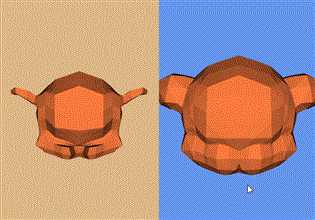VTK使用矢量数据弯曲几何体
Posted
tags:
篇首语:本文由小常识网(cha138.com)小编为大家整理,主要介绍了VTK使用矢量数据弯曲几何体相关的知识,希望对你有一定的参考价值。
vtkWarpVector is a filter that modifies point coordinates by moving points along vector times the scale factor. Useful for showing flow profiles or mechanical deformation. The filter passes both its point data and cell data to its output.
沿法向膨胀

#!/usr/bin/env python import vtk inputPolyData = vtk.vtkPolyData() sphereSource = vtk.vtkSphereSource() sphereSource.SetPhiResolution(15) sphereSource.SetThetaResolution(15) sphereSource.Update() inputPolyData = sphereSource.GetOutput() # merge duplicate points, and/or remove unused points and/or remove degenerate cells clean = vtk.vtkCleanPolyData() clean.SetInputData(inputPolyData) # Generate normals normals = vtk.vtkPolyDataNormals() normals.SetInputConnection(clean.GetOutputPort()) normals.SplittingOff() # vtkWarpVector is a filter that modifies point coordinates by moving points along vector times the scale factor # Warp using the normals (deform geometry with vector data) warp = vtk.vtkWarpVector() warp.SetInputConnection(normals.GetOutputPort()) # Set the input data arrays that this algorithm will process # The fieldAssociation refers to which field in the data object the array is stored warp.SetInputArrayToProcess(0, 0, 0,vtk.vtkDataObject.FIELD_ASSOCIATION_POINTS, vtk.vtkDataSetAttributes.NORMALS) # Specify value to scale displacement warp.SetScaleFactor(1.0) # Visualize the original and warped models colors = vtk.vtkNamedColors() mapper = vtk.vtkPolyDataMapper() mapper.SetInputConnection(warp.GetOutputPort()) warpedActor = vtk.vtkActor() warpedActor.SetMapper(mapper) warpedActor.GetProperty().SetColor(colors.GetColor3d("Flesh")) originalMapper = vtk.vtkPolyDataMapper() originalMapper.SetInputConnection(normals.GetOutputPort()) originalActor = vtk.vtkActor() originalActor.SetMapper(originalMapper) originalActor.GetProperty().SetInterpolationToFlat() # Set the shading interpolation method for an object originalActor.GetProperty().SetColor(colors.GetColor3d("Flesh")) renderWindow =vtk.vtkRenderWindow() renderWindow.SetSize(640, 480) # Create a camera for all renderers camera = vtk.vtkCamera() # Define viewport ranges: (xmin, ymin, xmax, ymax) leftViewport = [0.0, 0.0, 0.5, 1.0] rightViewport =[0.5, 0.0, 1.0, 1.0] # Setup both renderers leftRenderer = vtk.vtkRenderer() leftRenderer.SetViewport(leftViewport) leftRenderer.SetBackground(colors.GetColor3d("Burlywood")) leftRenderer.SetActiveCamera(camera) rightRenderer = vtk.vtkRenderer() rightRenderer.SetViewport(rightViewport) rightRenderer.SetBackground(colors.GetColor3d("CornFlower")) rightRenderer.SetActiveCamera(camera) leftRenderer.AddActor(originalActor) rightRenderer.AddActor(warpedActor) rightRenderer.ResetCamera() renderWindow.AddRenderer(rightRenderer) renderWindow.AddRenderer(leftRenderer) style = vtk.vtkInteractorStyleTrackballCamera() interactor = vtk.vtkRenderWindowInteractor() interactor.SetRenderWindow(renderWindow) interactor.SetInteractorStyle(style) renderWindow.Render() interactor.Start()

膨胀导入的STL模型

#!/usr/bin/env python import vtk inputPolyData = vtk.vtkPolyData() readerSTL = vtk.vtkSTLReader() readerSTL.SetFileName("Suzanne.stl") readerSTL.Update() inputPolyData = readerSTL.GetOutput() # merge duplicate points, and/or remove unused points and/or remove degenerate cells clean = vtk.vtkCleanPolyData() clean.SetInputData(inputPolyData) # Generate normals normals = vtk.vtkPolyDataNormals() normals.SetInputConnection(clean.GetOutputPort()) normals.SplittingOff() # Turn off the splitting of sharp edges # vtkWarpVector is a filter that modifies point coordinates by moving points along vector times the scale factor # Warp using the normals (deform geometry with vector data) warp = vtk.vtkWarpVector() warp.SetInputConnection(normals.GetOutputPort()) # Set the input data arrays that this algorithm will process # The fieldAssociation refers to which field in the data object the array is stored warp.SetInputArrayToProcess(0, 0, 0,vtk.vtkDataObject.FIELD_ASSOCIATION_POINTS, vtk.vtkDataSetAttributes.NORMALS) # Specify value to scale displacement warp.SetScaleFactor(0.3) # Visualize the original and warped models colors = vtk.vtkNamedColors() mapper = vtk.vtkPolyDataMapper() mapper.SetInputConnection(warp.GetOutputPort()) warpedActor = vtk.vtkActor() warpedActor.SetMapper(mapper) warpedActor.GetProperty().SetColor(colors.GetColor3d("Flesh")) originalMapper = vtk.vtkPolyDataMapper() originalMapper.SetInputConnection(normals.GetOutputPort()) originalActor = vtk.vtkActor() originalActor.SetMapper(originalMapper) originalActor.GetProperty().SetInterpolationToFlat() # Set the shading interpolation method for an object originalActor.GetProperty().SetColor(colors.GetColor3d("Flesh")) renderWindow =vtk.vtkRenderWindow() renderWindow.SetSize(640, 480) # Create a camera for all renderers camera = vtk.vtkCamera() # Define viewport ranges: (xmin, ymin, xmax, ymax) leftViewport = [0.0, 0.0, 0.5, 1.0] rightViewport =[0.5, 0.0, 1.0, 1.0] # Setup both renderers leftRenderer = vtk.vtkRenderer() leftRenderer.SetViewport(leftViewport) leftRenderer.SetBackground(colors.GetColor3d("Burlywood")) leftRenderer.SetActiveCamera(camera) rightRenderer = vtk.vtkRenderer() rightRenderer.SetViewport(rightViewport) rightRenderer.SetBackground(colors.GetColor3d("CornFlower")) rightRenderer.SetActiveCamera(camera) leftRenderer.AddActor(originalActor) rightRenderer.AddActor(warpedActor) rightRenderer.ResetCamera() renderWindow.AddRenderer(rightRenderer) renderWindow.AddRenderer(leftRenderer) style = vtk.vtkInteractorStyleTrackballCamera() interactor = vtk.vtkRenderWindowInteractor() interactor.SetRenderWindow(renderWindow) interactor.SetInteractorStyle(style) renderWindow.Render() interactor.Start()

参考:
VTK: vtkWarpVector Class Reference
VTK/Examples/Cxx/PolyData/WarpSurface
VTK/Examples/Python/PolyData/WarpVector.py
An algorithm for inflating/deflating (offsetting, buffering) polygons
以上是关于VTK使用矢量数据弯曲几何体的主要内容,如果未能解决你的问题,请参考以下文章
